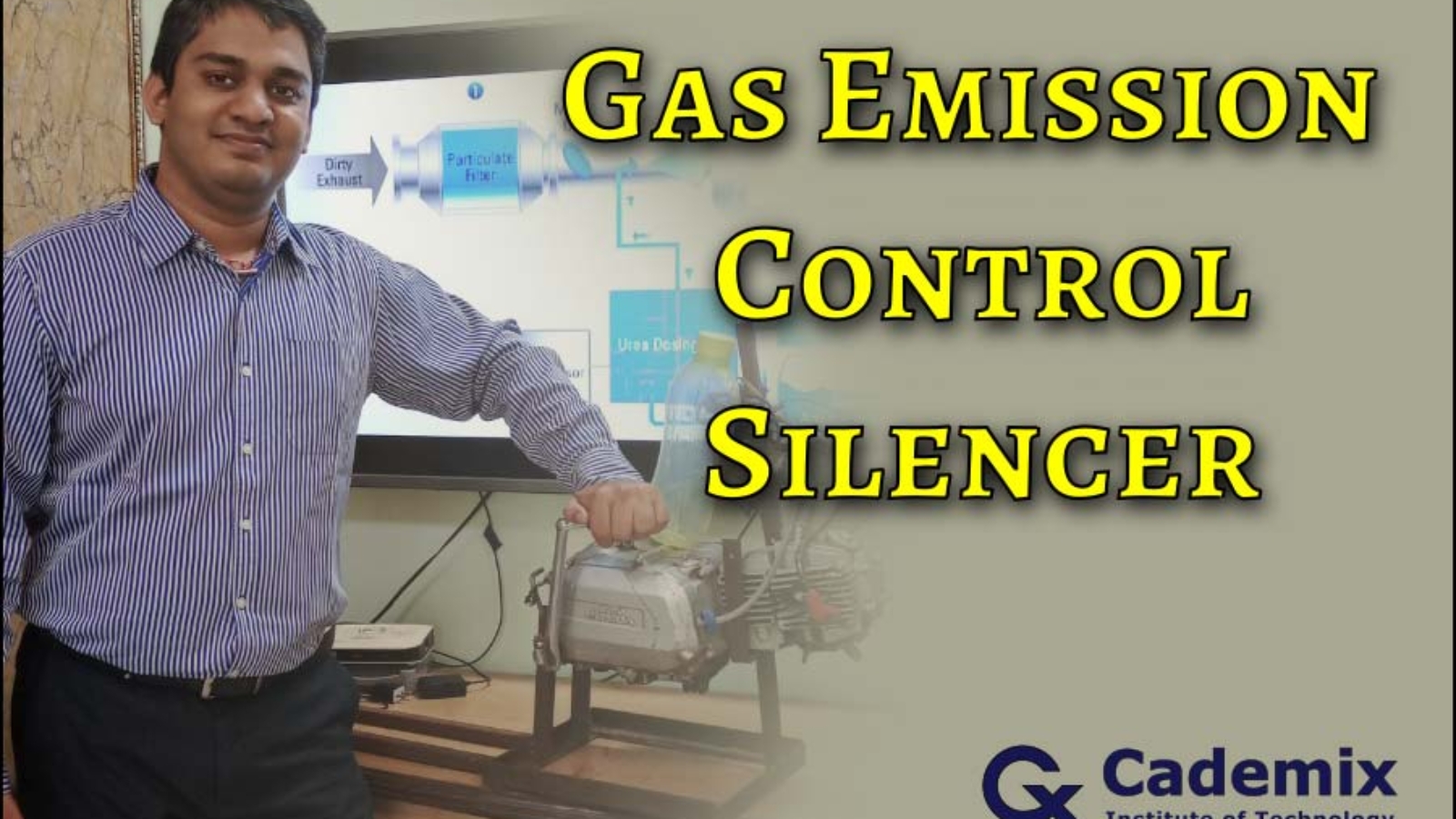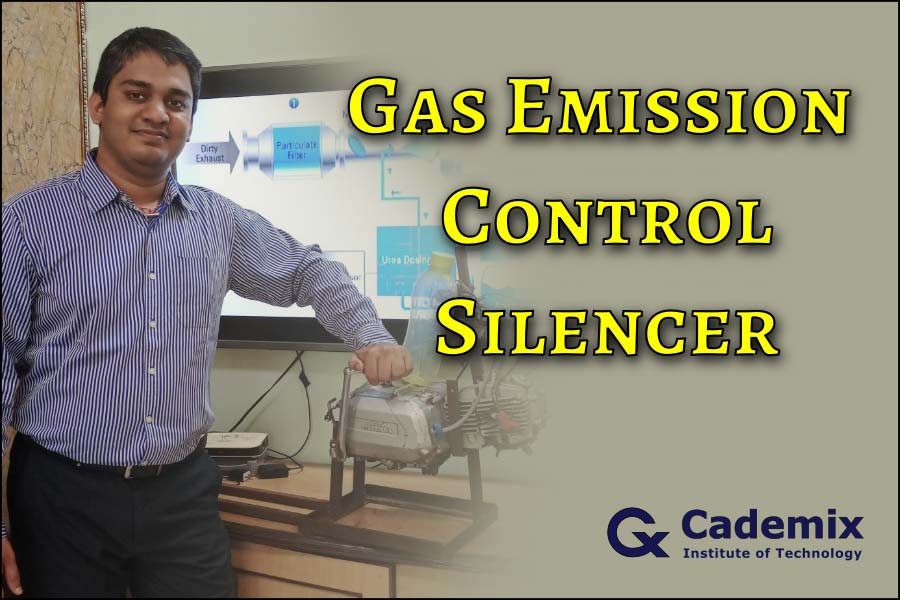
This articles describes the working of Gas Emission Control silencer and also explains how it is better than all the other technologies available.
An Article by Shreyash More, Cademix Institute of Technology
Air Pollution – A major Concern for the world
Air pollution is major concern for many developing and poor countries. It consists of chemicals or particles in the air that can harm the health of humans, animals, and plants. It can create global warming and damage infrastructure.
Pollution enters the Earth’s atmosphere in many different ways. human beings create most of the air pollution from factories, cars, planes, or aerosol cans. So the most important thing to do is Gas Emission Control (GEC).
Effects of air pollution
On human beings
Air pollution causes wide range of health problems. Short term effects include illnesses such as pneumonia or bronchitis. They also include discomfort such as irritation to the nose, throat, eyes, or skin. Air pollution can also cause headaches, dizziness, and nausea. Long-term effects include heart disease, lung cancer, and respiratory diseases such as emphysema. Air pollution can also cause long-term damage to people’s nerves, brain, kidneys and other parts.
On the Environment
Air pollution particles eventually fall back to Earth. Air pollution can directly contaminate the surface of bodies of water and soil. This can kill crops or reduce their yield. It can kill young trees and other plants.
Sulph0ur dioxide and nitrogen oxide particles in the air, can create acid rain when they mix with water and oxygen in the atmosphere. These air pollutants come mostly from coal-fired power plants and motor vehicles. When acid rain falls to Earth, it damages plants by changing soil composition; degrades water quality in rivers, lakes and streams; damages crops; and can cause buildings and monuments to decay.
Global warming is an environmental phenomenon caused by natural and anthropogenic air pollution. It refers to rising air and ocean temperatures around the world. This temperature rise is at least partially caused by an increase in the amount of greenhouse gases in the atmosphere. Carbon dioxide is a greenhouse gas that has had the biggest effect on global warming. Carbon dioxide emits into the atmosphere by burning fossil fuels (coal, gasoline, and natural gas).
Humans have come to rely on fossil fuels to power cars and planes, heat homes, and run factories. Other greenhouse gases emitted by natural and artificial sources also include methane, nitrous oxide, and fluorinated gases. Methane is a major emission from coal plants and agricultural processes. Nitrous oxide is a common emission from industrial factories, agriculture, and the burning of fossil fuels in cars. Fluorinated gases, such as hydrofluorocarbons, are emitted by industry. Fluorinated gases are often used instead of gases such as chlorofluorocarbons (CFCs). CFCs have been outlawed in many places because they deplete the ozone layer. Therefore, Multiphysical Energy Planning and Sustainable Development is one of the major priorities in Europe.
Currently used air pollution control technology
Catalytic converter
In the research paper named “Catalytic converter for automotive exhaust emission” in institute of technology, normal university by author Julia M Pardiwala, Femina Patel & Sanjay Patel in the year 2011. We learned the working of catalytic converter. catalytic converter consists of two blocks. First is reduction block which consists of platinum & Rhodium and second block consists of platinum & palladium. In first block NOx gets split into oxygen & nitrogen, both combine with another oxygen and nitrogen molecule to form their molecule which is harmless. Whereas in second block the CO molecule attracts oxygen molecule to form CO2 which is not harmful. Thus, this type of silencer is widely used. The only drawback is the cost of these silencer is very high due to platinum, palladium and rhodium.
Aqua silencer
In the research paper named “Aqua silencer” published in international journal of science & technology by authors Rahul S. Padaval & Nitin Patil in the year 2016, ( http://www.ijstm.com/images/short_pdf/1459267105_295N.pdf ) we learn the working of aqua silencer. The exhaust gases from engine enters from inlet to aqua silence then perforated tube convert high mass of bubble to low mass of bubble. Then this gas passes through charcoal layer which again purify the gases. This charcoal layer is highly porous & possess extra free valence so it having high absorption capacity. During that gases get contact with lime water they chemically react with it. The charcoal layer covers the outer shell which fits with water due to reduction of emission.
Urea-SCR technology
In the research paper named “Research status & development trends of UREA-SCR technology” published in 4th international conference on mechatronics, materials, chemistry & computer engineering by authors Zhanfeng Qi, Shusen Li, Xiuli Guo, Wuqiang Long in year 2015, ( https://www.atlantis-press.com/proceedings/icmmcce-15/25844557 ) we learn the reaction of urea with NOx. We learn that we can control concentration of NOx in the exhaust gases by spraying urea solution in the required quantity. Data control unit helps in determining quantity sprays.
Refractory and activated charcoal silencer
In the research paper named “fabrication of emission control silencer for 2-stroke petrol engine using refractory and activated carbon layer” published in International journal of science, engineering and technology by Pavan kumar, Dr.Rajagopal, Dr Hiregoudar yerrana gowda and Raghuram In year 2015 ( https://www.ijset.in/wp-content/uploads/2015/09/10.2348.ijset09151157.pdf ), we learn how the concentration of refractory and activated carbon affects the CO and Unburned Hydrocarbons. We learn how the quantity of refractory and activated carbon is varied and values are taken until we get the desired values of CO and unburned HC as per the norms of pollution. Also, as we increase the quantity of activated carbon the level of CO and HC goes on reducing.
Construction and assembly of Gas Emission control silencer
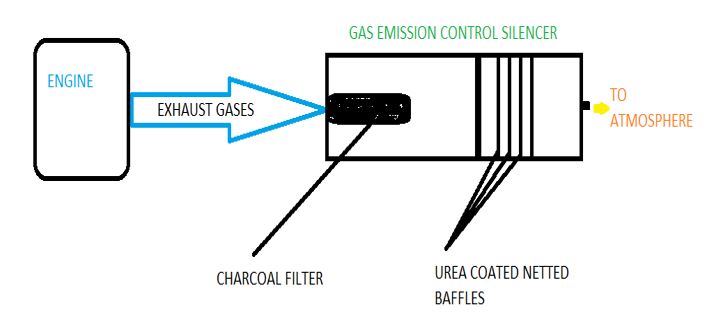
1. At first, we cut the L-shaped bar into 4 pieces of length 310mm and then weld them together with the help of electrode welding to form a rectangular base of the engine mounting.
2. We then cut the square hollow rods in lengths 210mm so as to support the engine movement.
3. We mount the engine on the base and extent the exhaust pipe so we can attach the silencer to it.
4. For fabrication of silencer we first attach a perforated tube to the exhaust pipe and cover it with carbon filter.
5. We then attach a screw rod of length 180mm to it.
6. We then cut the stainless steel net into circular shape of diameter 105mm and 33 in number.
7. We prepare urea solution by heating it in water.
8. We dip the cut net into the solution and then let it dry until we see a thin film of urea deposited over it.
9. We do it for all the 33 nets we repeat this process 3-4 times and then attach it on the screw rod by making hole in center and placing a washer between them, so as to allow space for air to pass freely.
10. At end we used nuts to fix the nets in place so that it should not fall off or dislocate due to pressure of exhaust gases.
11. All the above assembly is then placed inside a cylindrical pipe of length 430mm and both its ends are sealed with help of casing plate.
12. The casing plate at end of silencer has an opening drilled for exhaust of gas to the atmosphere.
13. By this was we make Gas Emission Control Silencer.
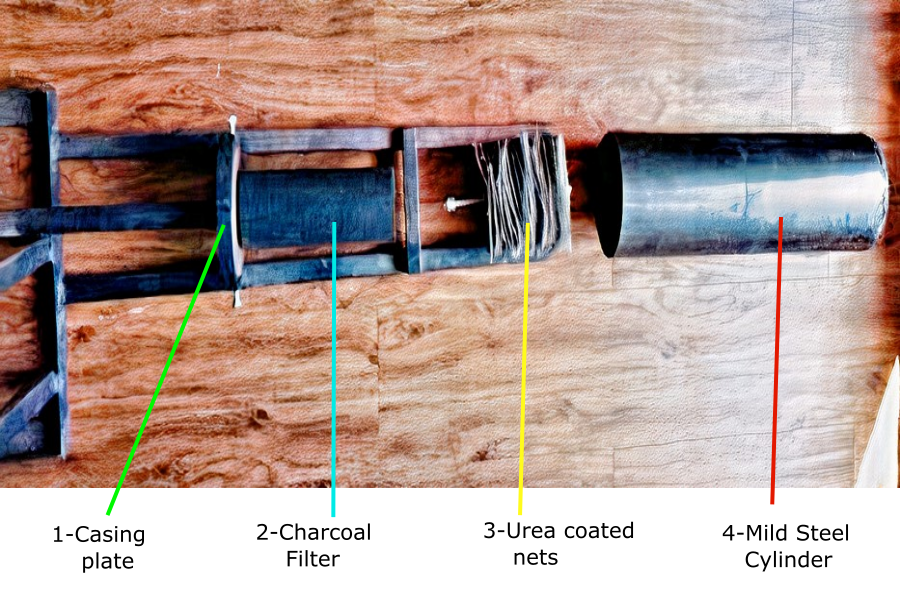
Working of Gas Emission Control Silencer:
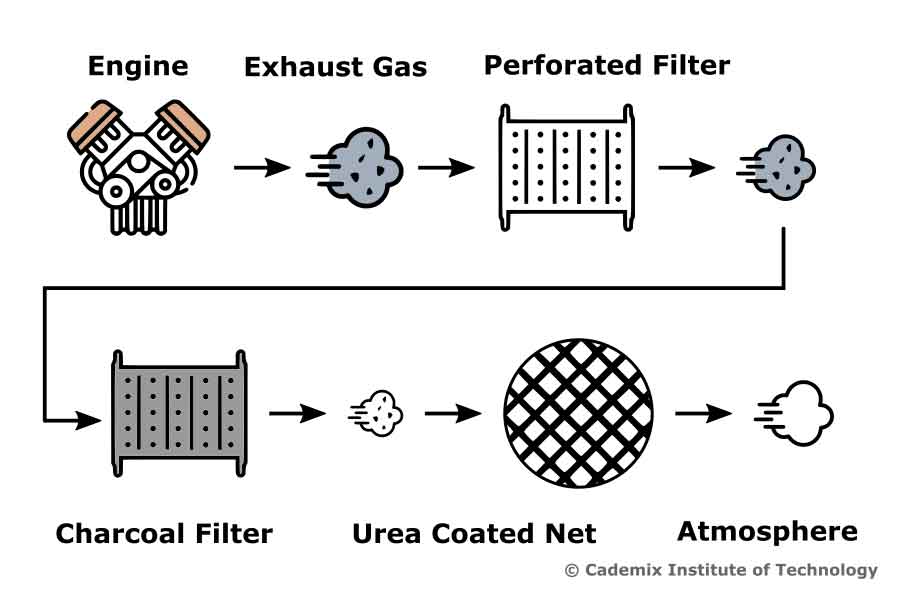
As shown from in the above figure, the exhaust gases from the engine comes via pipe into the silencer. At first the gas passes through perforated tube where the gas bubbles increase in size and the pressure reduces. This gas then passes from the carbon filter. As we know that the surface area of activated carbon is very large, so when the exhaust gas passes through the filter, the pollutant gases like HC and CO gets absorbed by the surface.
Then the gas passes through the urea coated nets. Because of the heat from the exhaust, the urea turns into molten states and reacts with NOx from the exhaust gas to form N2, H2O and CO2. After this the H2O formed is used for formation of ammonia in the chamber. This NH3 then reacts with NOX to form nitrogen and more water molecules. This cycle goes on continuing and the pollutants in the exhaust gases are filtered.
Analysis and conclusion
A gas analyzer was used for checking the concentration of different gases.
As the engine is of hero splendor, so we compared the emissions coming out of the Gas Emission Control Silencer with the stock silencer of the bike. This will help in determining which is better and by how much value.
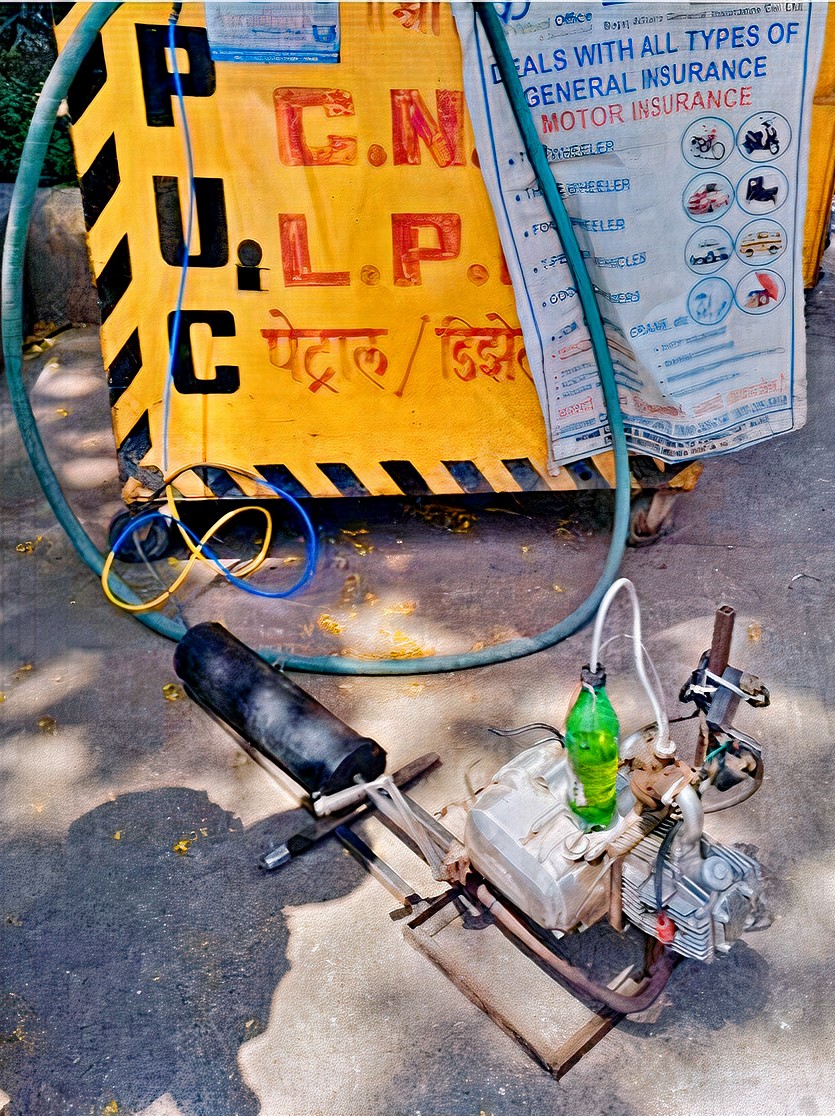
| POLLUTANT | CO | HC | CO2 |
| STOCK SILENCER | 0.2885% | 310 PPM | 7.20% |
| GEC SILENCER | 0.070% | 267 PPM | 1.70% |
| DIFFERENCE | 0.218% | 43 PPM | 5.5% |
From the above results we conclude that there is 0.218% reduction of CO, 16.104% reduction of HC and 5.5% reduction of CO2
From this analysis we learn that Gas Emission Control silencer is a better alternative as compared to conventional silencers. So, with further improvements in design, GEC silencers can replace conventional silencers.
Benefits of Using Gas Emission Control Silencer
- Cheap to manufacture
- Easy in construction.
- Raw materials are easily available.
- Light in weight.
- Cost of raw materials is less compared to aqua silencer and catalytic converter.
- Silencer is compact in size.
- Just by increasing or decreasing the number of urea coated nets, the level of pollutants thrown out can be controlled, following the pollution control norms.
- It is easy to maintain.
Related Keywords
Combustion, Sulfur, Fossil fuel, Atmospheric, Emit, Air-quality, Clean-air, Sulfur-dioxide, Smog, Particulate, Asthma, Clean air act, Monoxide, Human health, Sunlight, Protection, Nitrogen-dioxide, Power-plant, Environmental protection agency, Lungs, Sulphur-dioxide, Acidification, Ambient air, Ground level, Ground-level ozone, Greenhouse gas emissions, Air quality standards, Hazardous, Organic-compounds, Polluting, Oxides, Indoor air, Petroleum, Acid-deposition.

